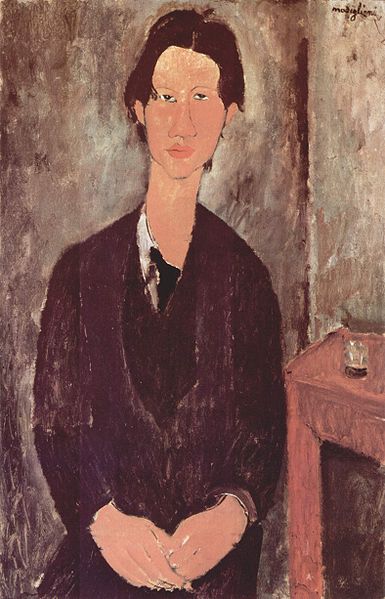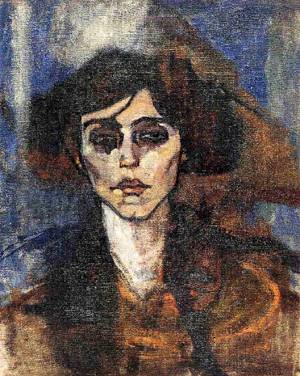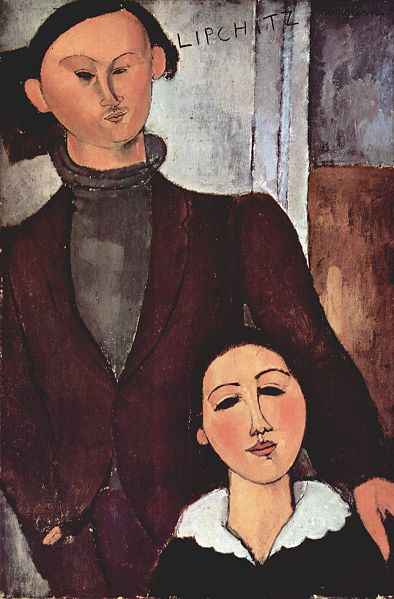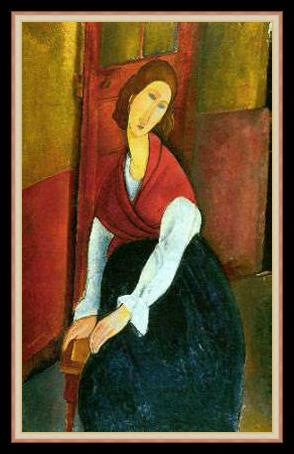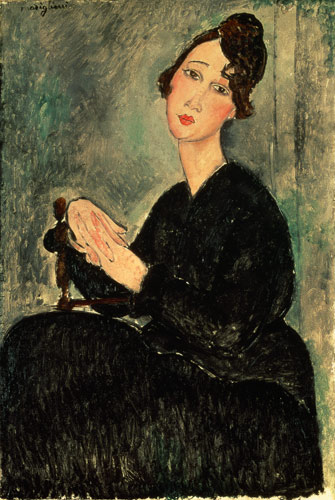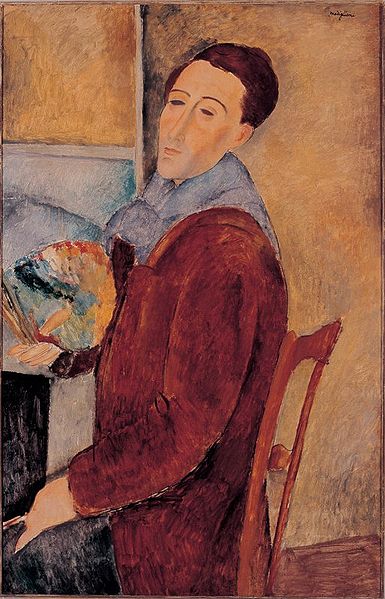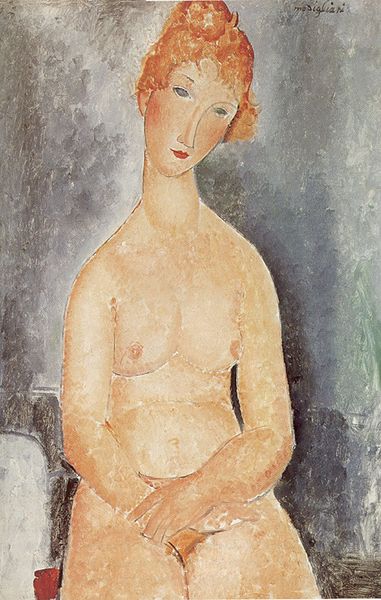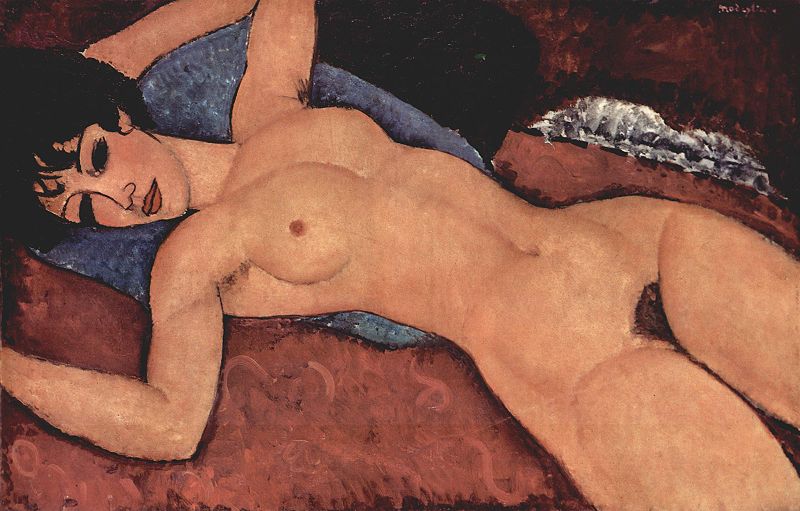<Back to Index>
- Physician Léon Charles Albert Calmette, 1863
- Painter and Sculptor Amedeo Clemente Modigliani, 1884
- Poet and Diplomat Pablo Neruda, 1904
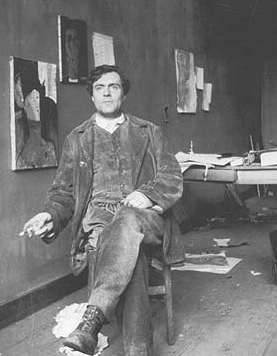
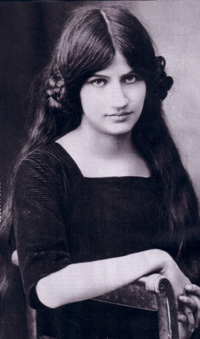
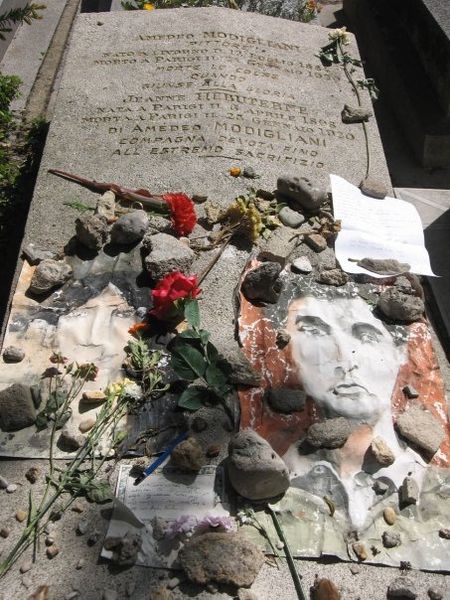
Amedeo Clemente Modigliani (July 12, 1884 – January 24, 1920) was an Italian artist who worked mainly in France. Primarily a figurative artist, he became known for paintings and sculptures in a modern style characterized by mask-like faces and elongation of form. He died in Paris of tubercular meningitis, exacerbated by poverty, overwork, and addiction to alcohol and narcotics.
Modigliani was born into a Jewish family in Livorno, Italy. A port city, Livorno had long served as a refuge for those persecuted for their religion, and was home to a large Jewish community. His maternal great-great-grandfather, Solomon Garsin, had immigrated to Livorno in the 18th century as a refugee. Modigliani
was the fourth child of Flaminio Modigliani and his French wife,
Eugenia Garsin. His father was a money-changer, but when his business
failed, the family lived in poverty. Amedeo's birth saved the family
from ruin, as according to an ancient law, creditors could not seize
the bed of a pregnant woman or a mother with a newborn child. The
bailiffs entered the family's home just as Eugenia went into labour;
the family protected their most valuable assets by piling them on top
of her. Modigliani
had a close relationship with his mother, who taught him at home until
he was ten. Beset with health problems after an attack of pleurisy when he was about eleven, a few years later he developed a case of typhoid fever. When he was sixteen he was taken ill again and contracted the tuberculosis which
would later claim his life. After Modigliani recovered from the second
bout of pleurisy, his mother took him on a tour of southern Italy: Naples, Capri, Rome and Amalfi, then north to Florence and Venice.
His
mother was, in many ways, instrumental in his ability to pursue art as
a vocation. Modigliani is known to have drawn and painted from a very
early age, and thought himself "already a painter", his mother wrote, even
before beginning formal studies. Despite her misgivings that launching
him on a course of studying art would impinge upon his other studies,
his mother indulged the young Modigliani's passion for the subject. At
the age of fourteen, while sick with typhoid fever, he raved in his
delirium that he wanted, above all else, to see the paintings in the Palazzo Pitti and the Uffizi in Florence. As Livorno's local museum only housed a sparse few paintings by the Italian Renaissance masters,
the tales he had heard about the great works held in Florence intrigued
him, and it was a source of considerable despair to him, in his
sickened state, that he might never get the chance to view them in
person. His mother promised that she would take him to Florence
herself, the moment he was recovered. Not only did she fulfil this
promise, but she also undertook to enroll him with the best painting
master in Livorno, Guglielmo Micheli. Modigliani
worked in Micheli's Art School from 1898 to 1900. Here his earliest
formal artistic instruction took place in an atmosphere deeply steeped
in a study of the styles and themes of 19th-century Italian art. In his
earliest Parisian work, traces of this influence, and that of his
studies of Renaissance art, can still be seen: this nascent work was shaped as much by such artists as Giovanni Boldini as by Toulouse-Lautrec. Modigliani
showed great promise while with Micheli, and only ceased his studies
when he was forced to, by the onset of tuberculosis. In 1901, whilst in Rome, Modigliani admired the work of Domenico Morelli,
a painter of melodramatic Biblical studies and scenes from great
literature. It is ironic that he should be so struck by Morelli, as
this painter had served as an inspiration for a group of iconoclasts
who went known by the title "the Macchiaioli" (from macchia — "dash
of colour", or, more derogatively, "stain"), and Modigliani had already
been exposed to the influences of the Macchiaioli. This minor, localized landscape movement was
possessed of a need to react against the bourgeois stylings of the
academic genre painters. While sympathetically connected to (and
actually pre-dating) the French Impressionists, the Macchiaioli did not make the same impact upon international art culture as did the contemporaries and followers of Monet, and are today largely forgotten outside of Italy. Modigliani's
connection with the movement was through Guglielmo Micheli, his first
art teacher. Micheli was not only a Macchiaiolo himself, but had been a
pupil of the famous Giovanni Fattori,
a founder of the movement. Micheli's work, however, was so fashionable
and the genre so commonplace that the young Modigliani reacted against
it, preferring to ignore the obsession with landscape that, as with
French Impressionism, characterized the movement. Micheli also tried to
encourage his pupils to paint en plein air,
but Modigliani never really got a taste for this style of working,
sketching in cafés, but preferring to paint indoors, and
especially in his own studio. Even when compelled to paint landscapes
(three are known to exist), Modigliani chose a proto-Cubist palette more akin to Cézanne than to the Macchiaioli. While
with Micheli, Modigliani not only studied landscape, but also
portraiture, still-life, and the nude. His fellow students recall that
the latter was where he displayed his greatest talent, and apparently
this was not an entirely academic pursuit for the teenager: when not
painting nudes, he was occupied with seducing the household maid. Despite
his rejection of the Macchiaioli approach, Modigliani nonetheless found
favour with his teacher, who referred to him as "Superman", a pet name
reflecting the fact that Modigliani was not only quite adept at his
art, but also that he regularly quoted from Nietzsche's Thus Spoke Zarathustra. Fattori himself would often visit the studio, and approved of the young artist's innovations. In 1902, Modigliani continued what was to be a life-long infatuation with life drawing, enrolling in the Accademia di Belle Arti (Scuola
Libera di Nudo, or "Free School of Nude Studies") in Florence. A year
later while still suffering from tuberculosis, he moved to Venice,
where he registered to study at the Istituto di Belle Arti. It is in Venice that he first smoked hashish and,
rather than studying, began to spend time frequenting disreputable
parts of the city. The impact of these lifestyle choices upon his
developing artistic style is open to conjecture, although these choices
do seem to be more than simple teenage rebellion, or the cliched hedonism and bohemianism that
was almost expected of artists of the time; his pursuit of the seedier
side of life appears to have roots in his appreciation of radical
philosophies, including those of Nietzsche. Having
been exposed to erudite philosophical literature as a young boy under
the tutelage of Isaco Garsin, his maternal grandfather, he continued to
read and be influenced through his art studies by the writings of
Nietzsche, Baudelaire, Carducci, Comte de Lautréamont, and others, and developed the belief that the only route to true creativity was through defiance and disorder. Letters
that he wrote from his 'sabbatical' in Capri in 1901 clearly indicate
that he is being more and more influenced by the thinking of Nietzsche. The work of Lautréamont was equally influential at this time. This doomed poet's Les Chants de Maldoror became the seminal work for the Parisian Surrealists of Modigliani's generation, and the book became Modigliani's favourite to the extent that he learnt it by heart. The
poetry of Lautréamont is characterized by the juxtaposition of
fantastical elements, and by sadistic imagery; the fact that Modigliani
was so taken by this text in his early teens gives a good indication of
his developing tastes. Baudelaire and D'Annunzio similarly appealed to the young artist, with their interest in corrupted beauty, and the expression of that insight through Symbolist imagery. Modigliani
wrote to Ghiglia extensively from Capri, where his mother had taken him
to assist in his recovery from tuberculosis. These letters are a
sounding board for the developing ideas brewing in Modigliani's mind.
Ghiglia was seven years Modigliani's senior, and it is likely that it
was he who showed the young man the limits of his horizons in Livorno.
Like all precocious teenagers, Modigliani preferred the company of
older companions, and Ghiglia's role in his adolescence was to be a
sympathetic ear as he worked himself out, principally in the convoluted
letters that he regularly sent, and which survive today. In 1906 Modigliani moved to Paris, then the focal point of the avant-garde.
In fact, his arrival at the centre of artistic experimentation
coincided with the arrival of two other foreigners who were also to
leave their marks upon the art world: Gino Severini and Juan Gris. He settled in Le Bateau-Lavoir, a commune for penniless artists in Montmartre,
renting himself a studio in Rue Caulaincourt. Even though this artists'
quarter of Montmartre was characterized by generalized poverty,
Modigliani himself presented — initially, at least — as one would expect
the son of a family trying to maintain the appearances of its lost
financial standing to present: his wardrobe was dapper without
ostentation, and the studio he rented was appointed in a style
appropriate to someone with a finely attuned taste in plush drapery and
Renaissance reproductions. He soon made efforts to assume the guise of
the bohemian artist, but, even in his brown corduroys, scarlet scarf
and large black hat, he continued to appear as if he were slumming it,
having fallen upon harder times. When he first arrived in Paris, he wrote home regularly to his mother, he sketched his nudes at the Académie Colarossi,
and he drank wine in moderation. He was at that time considered by
those who knew him as a bit reserved, verging on the asocial. He is noted to have commented, upon meeting Picasso who,
at the time, was wearing his trademark workmen's clothes, that even
though the man was a genius, that did not excuse his uncouth appearance. Within
a year of arriving in Paris, however, his demeanour and reputation had
changed dramatically. He transformed himself from a dapper academician
artist into a sort of prince of vagabonds. The poet and journalist Louis Latourette,
upon visiting the artist's previously well-appointed studio after his
transformation, discovered the place in upheaval, the Renaissance
reproductions discarded from the walls, the plush drapes in disarray.
Modigliani was already an alcoholic and a drug addict by this time, and
his studio reflected this. Modigliani's behaviour at this time sheds
some light upon his developing style as an artist, in that the studio
had become almost a sacrificial effigy for all that he resented about
the academic art that had marked his life and his training up to that
point. Not
only did he remove all the trappings of his bourgeois heritage from his
studio, but he also set about destroying practically all of his own
early work. The
motivation for this violent rejection of his earlier self is the
subject of considerable speculation. The self-destructive tendencies
may have stemmed from his tuberculosis and the knowledge (or
presumption) that the disease had essentially marked him for an early
death; within the artists' quarter, many faced the same sentence, and
the typical response was to set about enjoying life while it lasted,
principally by indulging in self-destructive actions. For Modigliani
such behaviour may have been a response to a lack of recognition; he
sought the company of artists such as Utrillo and Soutine, seeking acceptance and validation for his work from his colleagues. Modigliani's behavior stood out even in these Bohemian surroundings: he carried on frequent affairs, drank heavily, and used absinthe and hashish. While drunk, he would sometimes strip himself naked at social gatherings. He became the epitome of the tragic artist, creating a posthumous legend almost as well-known as that of Vincent van Gogh. During the 1920s, in the wake of Modigliani's career and spurred on by comments by André Salmon crediting
hashish and absinthe with the genesis of Modigliani's style, many
hopefuls tried to emulate his "success" by embarking on a path of
substance abuse and bohemian excess. While
this propaganda served as a rallying cry to those with a romantic
longing to be a tragic, doomed artist, these strategies did not produce
unique artistic insights or techniques in those who did not already
have them. In fact, art historians suggest that
it is entirely possible for Modigliani to have achieved even greater
artistic heights had he not been immured in, and destroyed by, his own
self-indulgences. During
his early years in Paris, Modigliani worked at a furious pace. He was
constantly sketching, making as many as a hundred drawings a day.
However, many of his works were lost — destroyed by him as inferior, left
behind in his frequent changes of address, or given to girlfriends who
did not keep them. He was first influenced by Henri de Toulouse-Lautrec, but around 1907 he became fascinated with the work of Paul Cézanne.
Eventually he developed his own unique style, one that cannot be
adequately categorized with other artists. He met the first serious
love of his life, Russian poet Anna Akhmatova,
in 1910, when he was 26. They had studios in the same building, and
although 21-year-old Anna was recently married, they began an affair. Tall
(Modigliani was only 5 foot 5 inches) with dark hair (like
Modigliani's), pale skin and grey-green eyes, she embodied Modigliani's
aesthetic ideal and the pair became engrossed in each other. After a
year, however, Anna returned to her husband. In
1909, Modigliani returned home to Livorno, sickly and tired from his
wild lifestyle. Soon he was back in Paris, this time renting a studio in Montparnasse. He originally saw himself as a sculptor rather than a painter, and was encouraged to continue after Paul Guillaume, an ambitious young art dealer, took an interest in his work and introduced him to sculptor Constantin Brancusi. Although a series of Modigliani's sculptures were exhibited in the Salon d'Automne of
1912, by 1914 he abandoned sculpting and focused solely on his
painting, a move precipitated by the difficulty in acquiring sculptural
materials due to the outbreak of war, and by Modigliani's physical debilitation. In Modigliani's art, there is evidence of the influence of art from Africa and Cambodia which he may have seen in the Musée de l'Homme,
but his stylizations are just as likely to have been the result of his
being surrounded by Mediæval sculpture during his studies in
Northern Italy (there is no recorded information from Modigliani
himself, as there is with Picasso and
others, to confirm the contention that he was influenced by either
ethnic or any other kind of sculpture). A possible interest in African tribal masks seems to be evident in his portraits. In both his painting and sculpture, the sitters' faces resemble ancient Egyptian painting
in their flat and mask-like appearance, with distinctive almond eyes,
pursed mouths, twisted noses, and elongated necks. However these same
characteristics are shared by Mediæval European sculpture and
painting. Modigliani painted a series of portraits of contemporary artists and friends in Montparnasse: Chaim Soutine, Moise Kisling, Pablo Picasso, Diego Rivera, Marie "Marevna" Vorobyev-Stebeslka, Juan Gris, Max Jacob, Blaise Cendrars, and Jean Cocteau, all sat for stylized renditions. At the outset of World War I, Modigliani tried to enlist in the army but was refused because of his poor health. Known as Modì, which translates as 'cursed' (maudit), by many Parisians, but as Dedo to his family and friends, Modigliani was a handsome man, and attracted much female attention. Women
came and went until Beatrice Hastings entered his life. She stayed with
him for almost two years, was the subject for several of his portraits,
including Madame Pompadour, and the object of much of his drunken wrath. When the British painter Nina Hamnett arrived
in Montparnasse in 1914, on her first evening there the smiling man at
the next table in the café introduced himself as Modigliani; painter and Jew. They became great friends. In 1916, Modigliani befriended the Polish poet and art dealer Leopold Zborovski and his wife Anna. The following summer, the Russian sculptor Chana Orloff introduced him to a beautiful 19-year-old art student named Jeanne Hébuterne, who had posed for Tsuguharu Foujita. From a conservative bourgeois background, Hébuterne was renounced by her devout Roman Catholic family
for her liaison with the painter, whom they saw as little more than a
debauched derelict, and, worse yet, a Jew. Despite her family's
objections, soon they were living together, and although
Hébuterne was the current love of his life, their public scenes
became more renowned than Modigliani's individual drunken exhibitions. On December 3, 1917, Modigliani's first one-man exhibition opened at the Berthe Weill Gallery. The chief of the Paris police was scandalized by Modigliani's nudes and forced him to close the exhibition within a few hours after its opening. After he and Hébuterne moved to Nice, she became pregnant and on November 29, 1918 gave birth to a daughter whom they named Jeanne (1918-1984). On a trip to Nice which had been conceived and organized by Leopold Zborovski, Modigliani, Foujita and other artists tried to sell their works to rich tourists.
Modigliani managed to sell a few pictures but only for a few francs
each. Despite this, during this time he produced most of the paintings
that later became his most popular and valued works. During
his lifetime he sold a number of his works, but never for any great
amount of money. What funds he did receive soon vanished for his habits. In
May 1919 he returned to Paris, where, with Hébuterne and their
daughter, he rented an apartment in the rue de la Grande
Chaumière. While there, both Jeanne Hébuterne and Amedeo
Modigliani painted portraits of each other, and of themselves. Although
he continued to paint, Modigliani's health was deteriorating rapidly,
and his alcohol-induced blackouts became more frequent. In
1920, after not hearing from him for several days, his downstairs
neighbor checked on the family and found Modigliani in bed delirious
and holding onto Hébuterne who was nearly nine months pregnant.
They summoned a doctor, but little could be done because Modigliani was
dying of the then-incurable disease tubercular meningitis. Modigliani
died on January 24, 1920. There was an enormous funeral, attended by
many from the artistic communities in Montmartre and Montparnasse. Hébuterne
was taken to her parents' home, where, inconsolable, she threw herself
out of a fifth-floor window two days after Modigliani's death, killing
herself and her unborn child. Modigliani was interred in Père Lachaise Cemetery. Hébuterne was buried at the Cimetière de Bagneux near
Paris, and it was not until 1930 that her embittered family allowed her
body to be moved to rest beside Modigliani. A single tombstone honors
them both. His epitaph reads: "Struck down by Death at the moment of
glory." Hers reads: "Devoted companion to the extreme sacrifice." Modigliani
died penniless and destitute—managing only one solo exhibition in his
life and giving his work away in exchange for meals in restaurants.
Since his death his reputation has soared. Nine novels, a play, a
documentary and three feature films have been devoted to his life.
